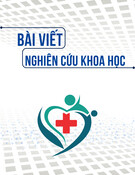
TẠP CHÍ Y häc viÖt nam tẬP 547 - th¸ng 2 - sè 1 - 2025
265
Characteristics in Breast Cancer. Journal of
Magnetic Resonance Imaging. 2020;52(5):1360-
1373. doi:10.1002/jmri.27241
4. Thakran S, Gupta PK, Kabra V, et al.
Characterization of breast lesion using T1-
perfusion magnetic resonance imaging:
Qualitative vs. quantitative analysis. Diagnostic
and Interventional Imaging. 2018;99(10):633-
642. doi:10.1016/j.diii.2018.05.006
5. Yi B, Kang DK, Yoon D, et al. Is there any
correlation between model-based perfusion
parameters and model-free parameters of time-
signal intensity curve on dynamic contrast
enhanced MRI in breast cancer patients? Eur
Radiol. 2014;24(5): 1089-1096. doi:10.1007/
s00330-014-3100-6
6. Travis RC, Key TJ. Oestrogen exposure and
breast cancer risk. Breast Cancer Research : BCR.
2003;5(5):239. doi:10.1186/bcr628
7. Honda M, Kataoka M, Onishi N, et al. New
parameters of ultrafast dynamic
contrast‐enhanced breast MRI using compressed
sensing. Magnetic Resonance Imaging. 2020;
51(1):164-174. doi:10.1002/jmri.26838
8. American College of Radiology BI-RADS
Committee. ACR BI-RADS Atlas: Breast Imaging
Reporting and Data System. 5th ed. American
College of Radiology; 2013.
9. Oldrini G, Fedida B, Poujol J, et al.
Abbreviated breast magnetic resonance protocol:
Value of high-resolution temporal dynamic
sequence to improve lesion characterization.
European Journal of Radiology. 2017;95:177-185.
doi:10.1016/j.ejrad.2017.07.025
10. Mann RM, Mus RD, van Zelst J, Geppert C,
Karssemeijer N, Platel B. A Novel Approach to
Contrast-Enhanced Breast Magnetic Resonance
Imaging for Screening: High-Resolution Ultrafast
Dynamic Imaging. Investigative Radiology. 2014;
49(9):579. doi:10.1097/RLI. 0000000000000057
RỐI LOẠN NHỊP TIM Ở PHỤ NỮ CÓ THAI
BẰNG HOLTER ĐIỆN TÂM ĐỒ 24 GIỜ
Trần Tất Đạt1, Lương Công Thức2,
Nguyễn Thế Huy3, Vũ Văn Bạ3
TÓM TẮT64
Mục tiêu: Nghiên cứu nhằm đánh giá tình trạng
rối loạn nhịp tim ở phụ nữ có thai bằng holter ĐTĐ 24
giờ tại bệnh viện Bưu điện. Kết quả: Các PN được
theo dõi Holter 24 giờ, có ít nhất một trong số các
triệu chứng liên quan đến rối loạn nhịp tim, trong đó
triệu chứng xuất hiện nhiều nhất là hồi hộp trống
ngực (94,1 %), trong khi triệu chứng choáng/ ngất ít
gặp nhất (11,8%). Rối loạn nhịp tim thường gặp là
ngoại tâm thu nhĩ và ngoại tâm thu thất (trên 50%)
và chủ yếu xảy ra ở giai đoạn 3 tháng đầu của thai kỳ
(47,6%). Nhịp xoang nhanh gặp ở PN mang thai tự
nhiên cao hơn so với mang thai theo cách IVF. Rối
loạn nhịp tim khác ở nhóm PN có cách thụ thai IVF
gặp nhiều hơn ở PN thai tự nhiên, ở các loại loạn nhịp
với p< 0,05. Tỷ suất chênh OR= 0,29. Kết luận:
Nghiên cứu cho thấy rối loạn nhịp tim thường gặp là
ngoại tâm thu nhĩ và ngoại tâm thu thất và chủ yếu
xảy ra ở giai đoạn 3 tháng đầu của thai kỳ. Tỷ lệ rối
loạn nhịp tim ở nhóm PN có cách thụ thai IVF cao hơn
so với nhóm PN có thai tự nhiên.
Từ khoá:
rối loạn
nhịp tim; phụ nữ có thai; holter ĐTĐ 24 giờ
SUMMARY
EVALUATION OF MATERNAL CARDIAC
1Bệnh viện Bưu Điện
2Bệnh viện Quân Y 103, Học viện Quân Y
3Bệnh viện E
Chịu trách nhiệm chính: Vũ Văn Bạ
Email: drbavuvan@gmail.com
Ngày nhận bài: 18.11.2024
Ngày phản biện khoa học: 20.12.2024
Ngày duyệt bài: 23.01.2025
ARRHYTHMIAS BY 24-HOUR HOLTER
MORNITORING
Objectives: This study aims to evaluate the
prevalence of arrhythmias in pregnant women using
24-hour Holter monitoring at the hospital of Post and
Telecommunications. Results: Among the monitored
women, at least one symptom related to arrhythmias
was reported, with palpitations being the most
common symptom (94.1%), while dizziness/syncope
was the least common (11.8%). The most frequently
observed arrhythmias were atrial and ventricular
premature beats (over 50%), predominantly occurring
in the first trimester (47.6%). The incidence of sinus
tachycardia was higher in women with natural
pregnancies compared to those who conceived via
IVF. Additionally, arrhythmias in the IVF group were
more prevalent than in the natural conception group,
with p<0.05. The odds ratio (OR) was 0.29.
Conclusions: The study indicates that the most
common arrhythmias are atrial and ventricular
premature beats, primarily occurring in the first
trimester of pregnancy. The prevalence of arrhythmias
is higher in the IVF group compared to those with
natural pregnancies.
Keywords:
arrhythmias;
pregnant women; 24-hour Holter monitoring
I. ĐẶT VẤN ĐỀ
Trong thời kỳ thai nghén, phụ nữ có nguy cơ
bị rối loạn nhịp tim cao hơn, chiếm khoảng 10%
các bệnh lý tim và thai kỳ. Những bệnh nhân có
tiền sử rối loạn nhịp tim hoặc bệnh tim cấu trúc
có thể đối mặt với nguy cơ xuất hiện, tái phát
cao hơn rối loạn nhịp tim trong thai kỳ, tuy nhiên
đa số các thai phụ phát hiện cơn đầu tiên của rối

vietnam medical journal n01 - FEBRUARY - 2025
266
loạn nhịp tim khi họ mang thai và không hề có
tiền sử mắc bệnh tim từ trước [1-3]. Trên những
thai phụ có cấu trúc tim bình thường, rối loạn
nhịp tim trong thai kỳ thường lành tính và đa số
các rối loạn nhịp tim thuộc dạng ngoại tâm thu
nhĩ hoặc ngoại tâm thu thất [4, 5]. Tuy nhiên,
một số nghiên cứu gần đây cho thấy ngày càng
gia tăng tỉ lệ xuất hiện rung nhĩ và nhanh thất ở
phụ nữ có thai. Kết quả là tăng tần suất nhập
viện, tăng nguy cơ mắc các bệnh lý tim mạch
nghiêm trọng trong thai kỳ, chẳng hạn như bệnh
cơ tim chu sinh, cũng như tăng nguy cơ tử vong
cho mẹ và thai nhi [1, 6-8]. Phương pháp điện
tâm đồ (ĐTĐ) bề mặt 12 chuyển đạo có thể xác
định được loại loạn nhịp tim, tuy nhiên khó có
thể đánh giá các rối loạn nhịp mang tính chất
cơn hoặc có tính chất chu kỳ. Holter ĐTĐ trong
24 giờ đặc biệt hữu ích để nhận ra các rối loạn
nhịp tim trong thai kỳ có thể xảy ra từng lúc,
đồng thời có thể phân loại dạng rối loạn nhịp từ
đó tìm ra các yếu tố thúc đẩy rối loạn nhịp tim
tiến triển nặng, nhằm tiên lượng sức khỏe cho
thai phụ và thai nhi, cũng như quyết định một kế
hoạch điều trị phù hợp. Chúng tôi thực hiện
nghiên cứu này nhằm đánh giá tình trạng rối
loạn nhịp tim ở phụ nữ có thai bằng holter ĐTĐ
24 giờ tại bệnh viện Bưu điện.
II. ĐỐI TƯỢNG VÀ PHƯƠNG PHÁP NGHIÊN CỨU
Nghiên cứu mô tả hồi cứu dựa trên kết quả
holter ĐTĐ 24 giờ được theo dõi trên 68 phụ nữ
có thai tại bệnh viện Bưu điện từ tháng 6 năm
2023 đến tháng 12 năm 2023.
Các phụ nữ có thai được chọn vào nghiên
cứu có tuổi thai hơn 03 tháng, đã được theo dõi
nhịp tim bằng holter ĐTĐ 24 giờ và phát hiện rối
loạn nhịp tim, đồng thời có đủ hồ sơ bệnh án với
thông tin đáp ứng các biến số cần nghiên cứu.
Chúng tôi loại trừ khỏi nghiên cứu những hồ sơ
không đầy đủ hoặc ghi nhận bệnh nhân đang sử
dụng máy tạo nhịp tạm thời hoặc vĩnh viễn, bệnh
nhân đang mắc các bệnh cấp tính.
Các biến số nghiên cứu được khai thác từ hồ
sơ bệnh án của bệnh nhân bao gồm triệu chứng
lâm sàng, xét nghiệm máu cơ bản và kết quả
holter ĐTĐ 24 giờ tại bệnh viện Bưu điện trong
thời gian khảo sát.
Xử lí số liệu và biểu diễn kết quả nghiên cứu
với biến định lượng dưới dạng trung bình ± độ
lệch chuẩn. Biểu diễn biến định tính dưới dạng
số lượng (n) và phần trăm (%). Sử dụng kiểm
định χ^2 để so sánh hai tỉ lệ có giá trị kỳ vọng >
5 và kiểm định Fisher’s Exact Test so sánh hai tỉ
lệ có giá trị kỳ vọng <5. Sử dụng kiểm định T-
test cho so sánh hai trung bình. Xử lý số liệu
bằng phần mềm thống kê SPSS 26.0. Sự khác
biệt có ý nghĩa thống kê với p<0,05.
III. KẾT QUẢ NGHIÊN CỨU
Khảo sát trên 68 phụ nữ có thai (PN) trong
thời gian từ tháng 6 năm 2023 đến tháng 12
năm 2023 thu được kết quả như sau:
3.1. Đặc điểm chung
Bảng 1. Đặc điểm chung của đối tượng
nghiên cứu
Đặc điểm
Chỉ số
Tuổi thai phụ trung bình (năm)
31 ± 9
Tuổi thai trung bình (tuần)
28 ± 15
Triệu chứng lâm sàng, n (%)
- Hồi hộp trống ngực
- Khó thở
- Tức ngực
- Choáng hoặc ngất
65 (94,1 %)
55 (80,9 %)
23 (33,8%)
08 (11,8%)
Tiền sử thai kỳ, n (%)
- Thai lần 1
- Thai lần 2
- Thai lần 3
- Thai lần 4
36 (53,0%)
16 (23,5%)
15 (22,1%)
01 (1,5%)
Tiền sử bệnh lý, n (%)
- Bệnh tuyến giáp
- Tăng huyết áp
- Đái tháo đường
- Rối loạn nhịp tim
06 (8,8%)
02 (2,9%)
0 (0%)
0 (0%)
Cách thụ thai, n (%)
- Tự nhiên
- IVF
21 (30,9%)
47 (69,1%)
Các PN được thu thập trong nghiên cứu có
tuổi trung bình là 31 ± 9 năm, trong đó PN nhiều
tuổi nhất là 40 tuổi, PN thấp tuổi nhất là 19 tuổi.
Tuổi thai nằm trong khoảng 13 tuần tới 38 tuần.
Trong đó tuổi thai theo giai đoạn 3 tháng đầu, 3
tháng giữa, 3 tháng cuối lần lượt là 31 PN
(45,5%), 37 PN (28,0%) và 18 PN (26,5%). Các
PN được theo dõi Holter 24 giờ, có ít nhất một
trong số các triệu chứng liên quan đến rối loạn
nhịp tim, trong đó triệu chứng xuất hiện nhiều
nhất là hồi hộp trống ngực (94,1 %), trong khi
triệu chứng choáng/ ngất ít gặp nhất (11,8%).
Kết quả nghiên cứu cho thấy đa số PN mang
thai lần thứ nhất (53,0%), chỉ có 01 PN mang
thai lần thứ 4 (1,5%). Các PN được đeo Holter
ĐTĐ 24 giờ phần lớn có cách thụ thai trong ống
nghiệm (IVF) chiếm khoảng 70%.
3.2. Đặc điểm rối loạn nhịp tim
Bảng 2. Phân bố các loại rối loạn nhịp
tim và tuổi thai theo giai đoạn thai kỳ
Các loại rối
loạn nhịp
tim
Tuổi thai (n)
n (%)
3 tháng
đầu
3 tháng
giữa
3 tháng
cuối
Nhịp xoang
nhanh
29
18
17
64
(94,1%)

TẠP CHÍ Y häc viÖt nam tẬP 547 - th¸ng 2 - sè 1 - 2025
267
Ngoại tâm
thu nhĩ
26
16
17
59
(86,7%)
Nhịp nhanh
nhĩ
12
02
10
24
(35,3%)
Rung nhĩ
01
0
01
02
(2,9%)
Ngoại tâm
thu thất
21
06
12
39
(57,4%)
Nhịp nhanh
thất
01
0
0
01
(1,5%)
N (%)
90
(47,6%)
42
(22,2%)
57
(30,2%)
189
(100%)
Rối loạn nhịp tim thường gặp là ngoại tâm
thu nhĩ và ngoại tâm thu thất (trên 50%) và chủ
yếu xảy ra ở giai đoạn 3 tháng đầu của thai kỳ
(47,6%).
Bảng 3. Mối liên quan giữa rối loạn nhịp
tim và cách thụ thai
Cách thụ thai
Rối loạn nhịp
Tự nhiên
IVF
p
OR
n
%
n
%
Nhịp xoang nhanh
20
95,2
44
93,6
0,79
1,36
Ngoại tâm thu nhĩ
14
66,6
45
95,7
0,01
0,09
Nhịp nhanh nhĩ
5
23,8
19
40,4
0,03
0,46
Rung nhĩ
0
0
2
4,3
-
-
Ngoại tâm thu thất
8
38,1
31
65,9
0,04
0,32
Nhịp nhanh thất
0
0
1
2,1
-
-
Nhịp xoang nhanh gặp ở PN mang thai tự
nhiên cao hơn so với mang thai theo cách IVF.
Rối loạn nhịp tim khác ở nhóm PN có cách thụ
thai IVF gặp nhiều hơn ở PN thai tự nhiên, ở các
loại loạn nhịp với p<0,05. Nhanh nhĩ gặp cao
hơn đáng kể ở nhóm IVF với tỷ suất chênh cao
nhất (OR=0,46).
IV. BÀN LUẬN
4.1. Đặc điểm rối loạn nhịp tim ở phụ
nữ có thai. Tần suất rối loạn nhịp tim ở phụ nữ
có thai ngày càng gia tăng vì gia tăng tuổi của
phụ nữ mang thai và tiến bộ y học với sự điều trị
thành công các bệnh lý tim ở trẻ sơ sinh và nhũ
nhi, giúp các bé gái này có thể trở thành những
phụ nữ có thể mang thai [3]. Tần suất này tăng
lên ở PN nhóm tuổi 41 tới 50 và điều kiện kinh tế
xã hội thấp. Bên cạnh đó, tần suất cao hơn đáng
kể nhờ PN có tiền sử bệnh tim mạch hoặc bệnh
đồng mắc liên quan [1, 7]. Trong các loạn rối
loạn nhịp tim xuất hiện ở phụ nữ có thai, kết quả
nghiên cứu của chúng tôi cho thấy chủ yếu gặp
ngoại tâm thu nhĩ và ngoại tâm thu thất (bảng
2), đây là rối loạn nhịp lành tính và dễ kiểm soát
hơn so với các rối loạn nhip khác như nhanh thất
và rung nhĩ. Kết quả nghiên cứu của chúng tôi
tương tư như kết quả được báo cáo trong một số
y văn, với tỉ lệ gặp hai loại loạn nhịp này là trên
50%. Các rối loạn nhịp phức tạp như nhanh thất,
rung nhĩ thường gặp ở PN có bệnh tim thực tổn
[1, 3, 9]. Cơ chế xuất hiện rối loạn nhịp ở phụ nữ
có thai được giải thích do liên quan đến sự thay
đổi yếu tố nội tiết, thần kinh, cảm xúc trong thời
kỳ mang thai, cũng như thay đổi cung lượng tim
và kháng lực mạch máu tạo thuận lợi khởi kích
các rối loạn nhịp [1, 3, 4]. Điều trị rối loạn nhịp
bằng thuốc trong thời kỳ mang thai có khả năng
gây tác động xấu đến thai nhi và khả năng gây
dị tật, đặc biệt trong giai đoạn hình thành cơ
quan (từ 5-10 tuần sau khi thụ thai). Các thử
nghiệm lâm sàng ngẫu nhiên đánh giá tác động
của thuốc chống loạn nhịp trong thai kỳ còn
thiếu, vì thế cần cân nhắc về hiệu quả và độ an
toàn trước khi bắt đầu điều trị, và chỉ sử dụng
liều thấp nhất có hiệu quả [1].
4.2. Mối liên quan giữa rối loạn nhịp
tim và cách thụ thai. Rối loạn nhịp tim ở nhóm
PN có cách thụ thai IVF gặp nhiều hơn ở PN thai
tự nhiên, ở các loại loạn nhịp với p< 0,05. Điều
này có thể giải thích do các PN có cách thụ thai
IVF được sử dụng các liệu pháp hormone trước,
trong và sau mang thai. Điều trị với phương thức
IVF có liên quan đến thay đổi các chỉ số huyết
động của PN trong những tuần đầu của thai kỳ.
Trong nghiên cứu phân tích tổng hợp của tác giả
Fujitake và cộng sự đã chỉ ra rằng các liệu pháp
hormone trong quá trình thực hiện IVF đã gây
kích thích tăng tần số tim đáng kể, từ việc điều
chỉnh xuống của tuyến yên đến mức estradiol
đỉnh [10]. Phân tích tổng hợp của 3 nghiên cứu
sử dụng giao thức kích thích buồng trứng bằng
GnRH kéo dài cho thấy tần số tim tăng đáng kể
3,78 nhịp mỗi phút (bpm) (±2,18) từ giai đoạn hạ
điều hòa tuyến yên đến mức estradiol cao nhất.
Cũng có sự tăng đáng kể về tần số tim là 2,61
bpm (±0,95) từ hạ điều hòa tuyến yên đến giai
đoạn hoàng thể. Tuy nhiên, các nghiên cứu trong
nghiên cứu tổng quan của Eri Fujitake không đề
cập đến khởi phát các rối loạn nhịp chi tiết [10].
Chúng tôi cho rằng, các liệu pháp hormone có thể
kích thích thần kinh giao cảm, tăng tính tự động
cơ tim, từ đó khởi phát các rối loạn nhịp tim giống
như cơ chế gây tăng tần số tim.
V. KẾT LUẬN
Trong nghiên cứu của chúng tôi thì rối loạn
nhịp tim thường gặp là ngoại tâm thu nhĩ và
ngoại tâm thu thất và chủ yếu xảy ra ở giai đoạn
3 tháng đầu của thai kỳ. Tỷ lệ rối loạn nhịp tim ở
nhóm PN có cách thụ thai IVF cao hơn so với
nhóm PN có thai tự nhiên.
TÀI LIỆU THAM KHẢO
1. Tamirisa, K.P., et al., Arrhythmias in Pregnancy.

vietnam medical journal n01 - FEBRUARY - 2025
268
JACC Clin Electrophysiol, 2022. 8(1): p. 120-135.
2. Huyền, H.T. and N.M. Thắng, BỆNH LÝ TIM Ở
PHỤ NỮ MANG THAI NGHIÊN CỨU TỔNG KẾT 3
NĂM. Tạp chí Y học Việt Nam, 2022. 521(1).
3. Tô, M.X.H., RỐI LOẠN NHỊP TIM TRONG THAI
KỲ: TẦN SUẤT, CHẨN ĐOÁN VÀ XỬ TRÍ.
4. Adamson, D.L. and C. Nelson-Piercy,
Managing palpitations and arrhythmias during
pregnancy. Heart, 2007. 93(12): p. 1630-6.
5. Ferrero, S., B.M. Colombo, and N. Ragni,
Maternal arrhythmias during pregnancy. Arch
Gynecol Obstet, 2004. 269(4): p. 244-53.
6. Lee, W. and D.B. Cotton, Peripartum
cardiomyopathy: current concepts and clinical
management. Clin Obstet Gynecol, 1989. 32(1):
p. 54-67.
7. Vaidya, V.R., et al., Burden of Arrhythmia in
Pregnancy. Circulation, 2017. 135(6): p. 619-621.
8. Lima, F.V., et al., National Trends and In-
Hospital Outcomes in Pregnant Women With
Heart Disease in the United States. Am J Cardiol,
2017. 119(10): p. 1694-1700.
9. Metz, T.D. and A. Khanna, Evaluation and
Management of Maternal Cardiac Arrhythmias.
Obstet Gynecol Clin North Am, 2016. 43(4): p.
729-745.
10. Fujitake, E., et al., Acute cardiovascular
changes in women undergoing in vitro fertilisation
(IVF), a systematic review and meta-analysis. Eur
J Obstet Gynecol Reprod Biol, 2020. 248: p. 245-251.
ĐẶC ĐIỂM TỶ LỆ TÍN HIỆU/NHIỄU VÀ TƯƠNG PHẢN/NHIỄU CỦA CHỤP
CẮT LỚP VI TÍNH LIỀU THẤP TRONG THEO DÕI CHẤN THƯƠNG SỌ NÃO
Nguyễn Đình Minh1, Phạm Thị Nga2
TÓM TẮT65
Mục tiêu: Nghiên cứu đặc điểm tín hiệu/ nhiễu
(SNR) và tương phản/ nhiễu (CNR) trên Cắt lớp vi tính
(CLVT) liều thấp trong theo dõi chấn thương sọ não
(CTSN). Đối tượng và phương pháp: Nghiên cứu
mô tả cắt ngang 35 bệnh nhân (BN) đang theo dõi
CTSN được chụp CLVT liều thấp sọ não với tham số
80kV tại bệnh viện Việt Đức từ tháng 5/2024 đến
tháng 10/2024. Các BN được đo tỷ trọng cấu trúc não
ở các vùng khác nhau và so sánh với CLVT liều tiêu
chuẩn, tham số 120 kV, về SNR và CNR. Kết quả:
SNR giảm trên CLVT liều thấp so với liều tiêu chuẩn ở
các vị trí vỏ não vùng trán (9,31 ± 2,992 so với 12,47
± 4,996), chất trắng vùng trán (6,77 ± 1,847 và 8,05
± 2,565), vỏ tiểu não (7,91 ± 2,889 và 8,99 ± 2,612),
cầu não (6,60 ± 1,487 và 7,69 ± 2,087) (p <0,05).
Tuy nhiên, SNR vùng máu tụ tăng từ 10,92 ± 2,821
lên 13,62 ± 4,201 (p<0,05). So sánh CNR cho thấy có
sự giảm trên CLVT liều thấp so với liều tiêu chuẩn ở
vùng trán (2,03 ± 0,551 so với 2,49 ± 0,572) và thuỳ
nhộng (0,16 ± 0,329 và 0,24 ± 0,254) (p<0,05). Tuy
nhiên CNR vùng máu tụ giữa hai nhóm là không có sự
khác biệt với p = 0,567. Kết luận: CLVT liều thấp
giảm đáng kể liều chiếu so với CLVT liều tiêu chuẩn
trong khi tổn thương máu tụ có SNR cao hơn và CNR
là không khác biệt.
Từ khoá:
CLVT liều thấp, Cắt lớp
vi tính, chấn thương sọ não, liều chiếu CT.
SUMMARY
SIGNAL-TO-NOISE RATIO AND CONTRAST-
TO-NOISE RATIO IN LOW-DOSE CT FOR
1Bệnh viện Hữu nghị Việt Đức
2Trường Đại học Y Hà Nội
Chịu trách nhiệm chính: Nguyễn Đình Minh
Email: minhdr24@gmail.com
Ngày nhận bài: 18.11.2024
Ngày phản biện khoa học: 23.12.2024
Ngày duyệt bài: 23.01.2025
MONITORING TRAUMATIC BRAIN INJURY
Objective: This study aims to investigate the
characteristics of signal-to-noise ratio (SNR) and
contrast-to-noise ratio (CNR) in low-dose computed
tomography (CT) for monitoring traumatic brain injury
(TBI). Subjects and Methods: A cross-sectional
descriptive study was conducted on 35 patients (P)
being monitored for TBI. Low-dose CT scans of the
brain using an 80 kV protocol were performed at Viet
Duc Hospital from May 2024 to October 2024. Brain
structure densities in different regions were measured
and compared with standard-dose CT scans (120 kV)
regarding radiation dose, SNR, and CNR. Results:
The SNR decreased in low-dose CT compared to
standard-dose CT at the following regions: frontal
cortex (9.31 ± 2.992 vs. 12.47 ± 4.996), frontal white
matter (6.77 ± 1.847 vs. 8.05 ± 2.565), cerebellar
cortex (7.91 ± 2.889 vs. 8.99 ± 2.612), and pons
(6.60 ± 1.487 vs. 7.69 ± 2.087) (p < 0.05). However,
SNR increased in hematoma regions from 10.92 ±
2.821 to 13.62 ± 4.201 (p < 0.05). The CNR
comparison showed a decrease in low-dose CT
compared to standard-dose CT in the frontal region
(2.03 ± 0.551 vs. 2.49 ± 0.572) and cerebellar vermis
(0.16 ± 0.329 vs. 0.24 ± 0.254) (p < 0.05). However,
CNR in hematoma regions showed no significant
difference between the two groups (p = 0.567).
Conclusion: Low-dose CT significantly reduces
radiation exposure compared to standard-dose CT
while providing higher SNR for hematoma and
maintaining comparable CNR.
Keywords:
low-dose CT, computed tomography,
traumatic brain injury, CT radiation dose.
I. ĐẶT VẤN ĐỀ
Chụp cắt lớp vi tính (CLVT) là một thăm
khám quan trọng trong chấn thương sọ não
(CTSN). Chụp CLVT ngày càng được ưa chuộng
do khả năng chẩn đoán vượt trội của nó, đặc
biệt là trong các trường hợp CTSN phức tạp. Mặt




















![Bài tập Con người và sức khỏe: [Mô tả chi tiết hoặc lợi ích của bài tập]](https://cdn.tailieu.vn/images/document/thumbnail/2025/20251123/thaohoang9203@gmail.com/135x160/95031763951303.jpg)





